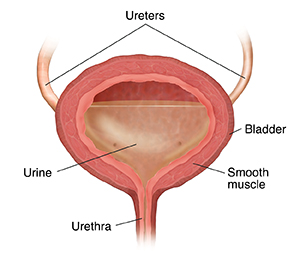The bladder is a small organ located in the pelvis and is responsible for storing and releasing urine.
It is triangular and hollow, and stores about 300 (range 200-400) mls of urine – a can of coke. The bladder has a smooth muscular wall – called the detrusor muscle – that allows it to get larger to store urine made by the kidneys, and to shrink to squeeze urine out of the body.
Bladder emptying is known as urination. It is normal to urinate 6-7 times in a 24-hour period – passing about 2L a day (if you drink, say, 2.5L). After urination 0-30 ml of urine remain in the bladder.

So, what does the bladder do? These are the main functions of the bladder:
1. Urine storage – the bladder acts as a reservoir for urine produced by the kidneys. It expands to accommodate increasing volumes of urine and contracts to maintain a constant pressure as the bladder fills.
2. Urine concentration – the bladder allows for the concentration of urine by reabsorbing some of the water and solutes from the urine. This helps maintain the body’s water balance.
3. Urine release – when the bladder reaches its capacity and the individual desires to empty it, the bladder contracts while the sphincter muscles at the base of the bladder relax. This coordination allows urine to be expelled through the urethra, the tube that connects the bladder to the external opening.
4. Control of urination – the bladder is under voluntary and involuntary control. Under normal circumstances, the conscious control allows an individual to voluntarily delay or initiate the act of urination.
However, the involuntary control system, regulated by the autonomic nervous system, can override conscious control in situations where immediate emptying is necessary (e.g., when the bladder is excessively full).
Parasympathetic control of bladder musculature, the contraction of which causes bladder emptying, originates with neurons in the sacral spinal cord segments (S2–S4).
Duration of urination
Interestingly, mammals empty their bladders on average for 21 seconds (standard deviation 13 seconds), despite a difference in bladder volume from 0.15 ml (mouse bladder) and 300 ml (human) to 18 L (elephant) and 300 L (blue whale).
It occurs because urethral length increases in proportion to the size of the animal, which amplifies gravitational force and flow rate. In other words, the urethra has evolved as a flow-enhancing device, enabling the urinary system to be scaled up without compromising its function.
Summary
We have described what does the bladder do. We hope you have found it helpful.
Other resources
How long do mammals urinate for?
What do the kidneys do (7 functions)?
How much water should I drink a day?
Last Reviewed on 23 August 2023
